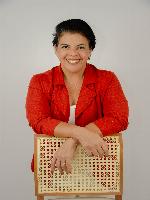

Event Information
Project Title: "Educational Innovation Without Borders: From Digital to Tangible"
Target Audience:
Teachers and educational administrators interested in integrating technology and innovation in resource-limited contexts.
Objectives:
Demonstrate how technology can be an accessible and transformative tool in education, even in low-resource settings.
Provide hands-on and replicable activities that combine the use of digital and tangible materials.
Inspire participants to become agents of change in their school communities.
Presentation at ISTE+ASCD:
1. Moment: Inspiring Introduction (10 minutes)
Opening: Start with an inspiring story of how technology has transformed the lives of students in underserved communities.
Project Introduction: Explain the concept of the "Portable Innovation Lab" and how it can be implemented in different contexts.
Audience Connection: Ask a provocative question: "How can we bring innovation to everyone, regardless of available resources?"
2. Time: Hands-on - Unplugged Activities (15 minutes)
Activity 1: "The Bridge of Collaboration": Divide participants into groups and provide simple materials (popsicle sticks, string, etc.). The challenge is to build a bridge that can support a certain weight, using principles of engineering and collaboration.
Activity 2: "The Digital Hero's Journey": Create a simple board game that simulates a student's journey in search of digital knowledge. Participants must solve challenges and make strategic decisions to advance in the game.
Discussion: After the activities, promote a brief discussion about how these concepts can be applied in the classroom, even without the use of digital technology.
3. Time: Exploring the Digital World - Plugged Activities (20 minutes)
Presentation of Accessible Digital Tools: Demonstrate the use of free and low-cost online tools, such as Google Workspace for Education, Scratch, and content creation applications.
Activity 1: “Creating a Virtual Museum”: Use Google Arts & Culture to explore artwork and create a collaborative virtual museum.
Activity 2: “Coding with Scratch”: Introduce the basics of visual programming with Scratch by creating a simple game or animation.
Demonstration of the Portable Kit: Present the prototype of the “Portable Innovation Lab”, showing how it can be used to carry out the activities presented.
4. Moment: Engagement and Reflection (15 minutes)
Discussion Circle: Promote a discussion circle for participants to share their experiences, ideas and challenges.
Action Plan: Encourage participants to create an action plan to implement the activities in their schools.
Additional Resources: Provide digital and printed materials with additional resources, such as tutorials, lesson plans and links to online tools.
Inspiring Closing: Conclude with a message of hope and empowerment, inviting participants to become agents of change in their communities.
Materials:
Portable kits with educational devices and materials.
Projector and screen for presentations and demonstrations.
Materials for practical activities (popsicle sticks, string, board games, etc.).
Digital materials (presentations, tutorials, lesson plans). Internet access.
The 'Portable Innovation Lab' project is based on research that highlights the importance of digital inclusion and the development of technological skills in educational environments with limited resources. Studies such as UNESCO reports on the impact of technology on education, such as https://www.unesco.org/pt/fieldoffice/brasilia/expertise/educational-management and the Ayrton Senna Institute's research on the use of mobile technologies for learning in low-income communities https://institutoayrtonsenna.org.br/ demonstrate the transformative potential of initiatives that empower teachers as agents of change. An example of a study related to the topic is the pdf file titled "INTEGRAL EDUCATION THROUGH COMPUTATIONAL THINKING - Ayrton Senna Institute" which contains information on the use of technologies for learning. Link: https://institutoayrtonsenna.org.br/app/uploads/2022/11/instituto-ayrton-senna-educacao-integral-por-meio-do-pensamento-computacional.pdf
The Porvir website has an article entitled "MOBILE LEARNING IN BRAZIL" that uses information from UNESCO on the use of mobile technologies for learning.
Link: https://porvir.org/wp-content/uploads/2015/08/Columbia_Aprendizagem_Movel_Integra.pdf
In addition, the literature on Puentedura's SAMR (Substitution, Augmentation, Modification, Redefinition) Model and Mishra and Koehler's TPACK (Technological Pedagogical Content Knowledge) support the project's pedagogical approach, which seeks to integrate technology in a meaningful way into the school curriculum.
SAMR Model: A Practical Guide for EdTech Integration:
This article provides an overview of the SAMR model, explaining each level and providing practical examples of how to apply the model in the classroom. This model is widely used to observe the degree to which digital technologies are incorporated into pedagogical practices. Link: https://www.schoology.com/blog/samr-model-practical-guide-edtech-integration
Dr. Ruben Puentedura's website: The website of Dr. Ruben Puentedura, creator of the SAMR model, offers presentations, articles and other resources related to the model. This website contains a wealth of information about the SAMR model. Link: http://www.hippasus.com/
TPACK (Technological Pedagogical Content Knowledge) by Mishra and Koehler:
TPACK Framework: This website provides an overview of the TPACK framework, explaining the seven components of knowledge and providing resources for teachers and researchers. The TPACK model is widely used to observe how teachers use digital technologies in the classroom. Link: http://tpack.org/
Technological Pedagogical Content Knowledge: A Framework for Teacher Knowledge: This original article by Mishra and Koehler describes the TPACK framework and its importance for integrating technology in education. Link: http://punya.educ.msu.edu/publications/journal_articles/mishra-koehler-tcr2006.pdf

Free Canva Account: Attendees will need a free Canva account to create and edit designs during the session. To sign up, visit: www.canva.com
Google Slides App (optional but recommended): While Google Slides can be accessed via a web browser, having the app installed on your tablet or smartphone can enhance the experience. Available on the App Store (iOS) and Google Play Store (Android).
Internet Access: A stable internet connection is essential to access Canva and Google Slides.
Up-to-date browser: It is recommended to use an up-to-date browser such as Google Chrome, Mozilla Firefox or Safari.
Headphones (optional): Headphones can help reduce distractions and improve concentration during the session.
| Related exhibitors: | Agile Education Marketing, TalkingPoints, T-Mobile for Education |